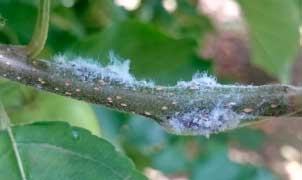Many growers have noticed white cotton-like masses on leaves, limbs, shoots, pruning wounds, and on the trunk of their apple trees. These white cotton-like masses represent a serious pest of apples in Australia: the woolly aphid.
Speaking with growers around Victoria, we have found that over the past decade, the prevalence of woolly aphid appears to be increasing.
There are many factors involved, including changes in management practices that result in providing a more favourable environment for the development of the aphid. For example, the planting of susceptible varieties and rootstocks, the use of inappropriate IPM strategies, insecticide resistance, the use of broad-spectrum insecticides that harm predators, and an increase in fertiliser use.
Woolly, sugary issues
Besides the insect damaging fruit and affecting tree health, the wool-like waxy material that covers their body can impede orchard operations—especially summer pruning, thinning and harvesting.
Honeydew—a sugar-rich fluid produced by the woolly aphid—can drip onto fruit resulting in sooty mould and the downgrading of fruit because of blackened or russeted areas.
Large populations of woolly aphid can create sticky and unpleasant working conditions for harvest crews, leaving purple stains on skin and clothing. This stickiness and the woolly filaments make orchard operations very uncomfortable.
Infestation above and below ground
Woolly aphid overwinters as an early-stage nymph called a crawler in cracks and crevices in the bark. Most disperse to the base of the tree and infest the roots.
While feeding on the roots, crawlers cause large galls to form. When spring approaches, crawlers migrate to the tree canopy.
Crawlers migrate between roots and shoots throughout the season but as winter approaches those moving to the roots form dormant colonies.
Compared with root colonies, aerial colonies are often kept under control by insecticide application for other pests such as codling moth.
It is very important to monitor the orchard to determine which trees should be treated with a soil drench. Every tree colonized by woolly aphid should be marked for treatment early the following season.
Penetrate the waxy covering
The waxy covering provides protection from some insecticides.
Therefore, in order to break surface tension of waxy material and allow insecticides to get in contact with pests, it is usually recommended on the label to add specific surfactant to the tank mix.
Due to some of the properties of surfactants (penetration and drying), most of the organosilicon surfactants have some insecticidal effect on soft body insects such as woolly aphid.
High volume applications of recommended insecticides may be necessary to penetrate the wax.
Control root colonies
Failure to control aerial infestations can result in underground infestations on susceptible rootstocks.
(Continued next month)
See this article in Tree Fruit Jan 2017




















